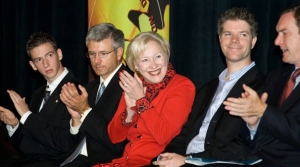by Nancy L. Zimpher, president
One of the greatest distinctions that sets the University of Cincinnati apart from the 4,200 degree-granting higher education institutions in the United States is our immense research capacity. In fact, UC stands among an elite group of 96 universities with "very high research activity," as classified by the Carnegie Foundation, and we are proud that UC ranks among our nation's top public research universities.
In 2007, UC's total research funding reached a record $333.5 million -- double the level of just 10 years ago. Such data, coupled with the number of coveted awards our faculty win and the number of our faculty in the National Academies, also set us apart from many of Ohio's other public universities. In fact, the only other public university in Ohio that joins UC on the Carnegie list of high-level research universities is The Ohio State University.
By emphasizing such facts and figures, I risk creating the impression that research is solely the realm of one type of university. As Cornell's President Emeritus Frank Rhodes suggests in a recent book, it is somewhat redundant to say "research university" -- akin (and I borrow his words) to saying "artistic painter" or "musical rock group."
It is true that, essentially, the discovery of new knowledge falls within the mission of nearly all of academia, along with teaching. In my view, teaching and research are inextricably intermingled, and on the UC campus, we have long embraced the idea that true learning takes place when what is taught is tested with hands-on experiences and built upon through research and discovery. Our university is not satisfied to rest on tradition and is today looking for new ways to introduce research experiences into the lives of our students, including our undergraduates.
Beyond the vital role that our research mission plays in the learning process and the creation of new knowledge, the quest for innovation that takes place at a research-extensive university, UC included, results in enormous benefit that reaches well outside the boundaries of our campus. The following recounts just a few of the ways in which this impact takes shape:
Economic engine -- Research universities are forces of enormous economic development for their regions and their states. As evidence, I point to a 2006 study by Appleseed Inc. that shows that UC, OSU and Case Western, in combination, account for about 68,000 jobs and $6.2 billion in annual economic activity within the state of Ohio. We also stand among the largest employers in our respective regions. Some 400,000 of our graduates live and work in Ohio, and our trio of universities -- two public, one private -- produces 80 percent of the research done in Ohio universities.
Force of innovation -- Research activities often lead to patents, tech transfer, new entrepreneurial endeavors, new products and new companies. In our 21st-century age of innovation and escalating global competition, this becomes an increasingly urgent issue for our nation. Closely related to this is our obligation to ensure an abundant flow of high-quality teachers and graduates in the science, technology, engineering and mathematics (STEM) fields.
Societal benefit/quality of life -- It may sound clichéd to say so, but university research truly does result in better lives for people around the world -- in uncountable life-saving and life-changing ways. One promising case in point among our world-class UC research teams is the work of professor Winston Whei-Yang Kao and research scientist Hongshan Liu, both in ophthalmology, who have found that adult bone-marrow stem cells may help cure certain genetic eye diseases. This issue of "UC Magazine" offers many more examples.
As you can see, research is a major enterprise at UC, one with impact far beyond our campus to the world at large. As a university community, we are ever mindful that we want to build on this capacity, enhance our research excellence and, in turn, transform the world.

 Issue Archive
Issue Archive